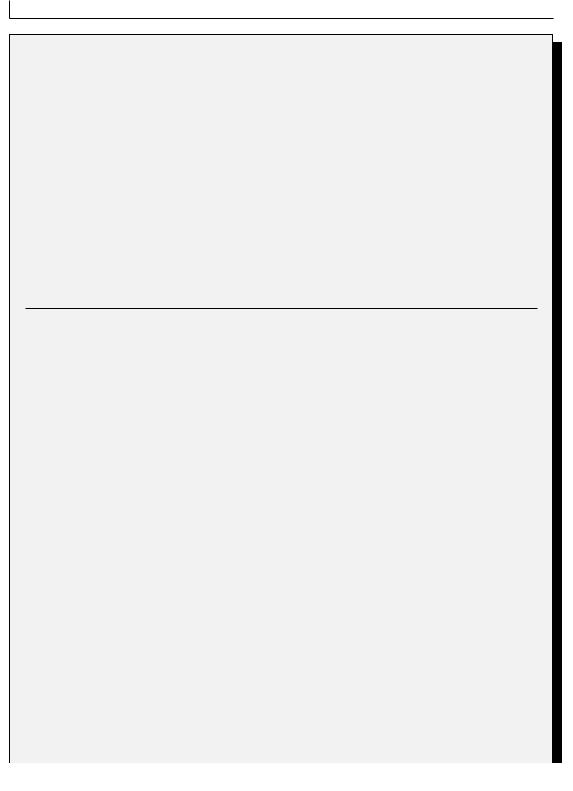
Global corporate finance - Kim
.pdf
472 INTERNATIONAL CAPITAL BUDGETING DECISIONS
Case Problem 18: Multinational Capital
Budgeting Practices
The literature on foreign capital investment theory reveals that business firms should use discounted cash flow techniques for ranking and selecting overseas projects because these methods recognize the time value of money and employ cash flows of a project over its life span. Table 18.6 illustrates the extent to which discounted cash flow methods were used by companies that were surveyed from 1980 to 1994. These empirical studies revealed two important points: first, discounted cash flow approaches are more popular than rules of thumb; second, internal rate of return is more popular than net present value.
Table 18.6 The use of primary project evaluation techniques
Evaluation method |
Oblak (1980) |
Kelly (1982) |
Stanley (1984) |
Kim (1984) |
Shao (1994) |
||||||||||
|
|
|
|
|
|
|
|
|
|
|
|
|
|
|
|
Payback |
10% |
18% |
5% |
|
12% |
25% |
|||||||||
ARR |
14% |
27% |
11% |
14% |
14% |
||||||||||
IRR |
60% |
36% |
65% |
62% |
40% |
||||||||||
NPV |
10% |
14% |
16% |
9% |
|
17% |
|||||||||
Others |
|
6% |
|
|
5% |
|
|
3% |
|
|
3% |
|
|
4% |
|
Total |
100% |
100% |
100% |
100% |
100% |
||||||||||
|
|
|
|
|
|
|
|
|
|
|
|
|
|
|
|
Thus, most MNCs use discounted cash flow approaches for ranking and selecting overseas projects. The five studies cited in table 18.6 show that at least half of the respondents used discounted cash flow approaches, ranging from 50 percent according to Kelly’s study to 81 percent in Stanley’s study. Although the findings vary in these surveys, their overriding implication suggests that discounted cash flow approaches are unmistakably more popular than rules of thumb. In fact, the use of those techniques favored by academicians has become so commonplace in recent years that we do not need more empirical studies to confirm the adoption of discounted cash flow techniques by most MNCs.
The results are not strictly comparable, because terms such as “exclusive,” “most important,” and “primary” used by these surveys are not synonymous. On the other hand, the key characteristics for most of these surveys are so similar that our inferences are valid. The firms surveyed were drawn mostly from large industrial categories; sample sizes were relatively large; respondents and sample groups were surveyed by mail; and research methods were carefully adhered to. The respondents revealed that most companies use discounted cash flow approaches for foreign investment projects. With this fact established, it is reasonable to expect that firms using such sophisticated techniques as internal rate of return should make better investment decisions and thus perform better than firms using such unsophisticated techniques as payback.

CASE PROBLEM 18 |
473 |
|
|
Case Questions
1What are the disadvantages of the payback method and the average-rate-of-return method?
2What are the conditions under which the net-present-value and internal-rate-of-return methods will lead to the same capital-budgeting decision?
3Why is the net-present-value method theoretically better than the internal-rate-of-return method?
4Why is internal rate of return more popular than net present value in practice?
5The website of the Bank for International Settlements, www.bis.org/cbanks.htm, and the website of the US State Department, www.state.gov, give economic information on most countries around the world. Access these websites to obtain economic information that can be used to assess the feasibility of projects in a developing country.
Source: Kim, S. H. and G. Ulferts, “A Summary of Multinational Capital Budgeting Practices,” Managerial Finance, Spring 1996, pp. 75–85.

CHAPTER 19
The Cost of Capital for Foreign Projects
Opening Case 19 : GM’s Target Debt Ratio in its
Overseas Expansion
Analysts say that global vehicle production will double in the next 20 years. “Projected growth in the global auto industry is going to occur in places other than North America and Europe, and most of that growth is going to occur in Asia,” said Jim Bright, a Ford spokesman in Detroit. Thus, it should come as no surprise that European, Japanese, and US automakers have been expanding their operations in Asia aggressively.
General Motors (GM) sold 443,000 vehicles in the Asia-Pacific market in 1998, which accounted for 4 percent of the market. And GM wished to expand its Asian market to 10 percent by 2005. To accomplish its sales goal, GM has recently begun to establish a strong presence in Asia through construction of new plants, acquisitions and alliances, and strategic partnerships (see figure 19.1). As part of its aggressive expansion in Asia, GM made an offer to buy Daewoo Motor of Korea for $5.5 billion in December 1999. Daewoo Motors, the debt-laden number two Korean automaker, is an affiliate of the Daewoo Group, which is being dismantled by its creditors after amassing almost $80 billion in liabilities.
GM’s plan for Daewoo Motors includes a $5.5 billion cash payment, its offer of a one-third equity stake to creditors, and its demand for creditors to write off a substantial portion of their Daewoo Motors’ debt. All these financial arrangements are designed to insure that the new Daewoo Motors’s balance sheet will reflect a debt ratio of 40 percent. Analysts think that this 40 percent debt ratio is GM’s target debt ratio, the combination of equity and debt that minimizes its cost of capital and maximizes its market value. How did GM arrive at a 40 percent debt ratio? In fact, GM’s


476 THE COST OF CAPITAL FOR FOREIGN PROJECTS
Thailand. GM’s presence in Asia is formidable and will continue to grow, because otherwise it could risk losing its global leadership position. GM has automotive facilities and sales offices in 15 Asian countries. Main manufacturing and assembly operations are located in Australia, China, Indonesia, Korea, Vietnam, and Thailand.
Sources: “GM Offers Daewoo Creditors a Stake in Korean Firm in Exchange for Debt,” The Wall Street Journal, Dec. 21, 1999, p. A3; “GM Pursues New Links with Japanese,” The Wall Street Journal, Dec. 3, 1999, p. A3; “GM Alters Strategy in Asia Pacific,” The Detroit News, June 12, 2003, pp. 1B, 4B; and www.gm.com.
In chapter 18, we discussed two discounted cash flow approaches: the net-present-value method and the internal-rate-of-return method. These methods evaluate the net cash flows of a project in terms of the required rate of return to determine its acceptability. The actual required rate of return applied by a multinational company (MNC) may be the cost of capital adjusted for political and exchange risks.
In this chapter, we consider four major topics. First, we discuss the weighted average cost of capital and its component costs of capital (the cost of debt and the cost of equity). In addition, this first section explains how corporate and country characteristics influence the cost of capital for multinational cases. Second, we analyze a firm’s capital structure, which consists of long-term debt and common equity. In doing so, we explain how an MNC considers corporate and country characteristics when it establishes its capital structure. Third, we describe the relationship between the marginal cost of capital and foreign investment analysis. The marginal cost of capital refers to the cost of additional funds that the firm wishes to raise. Fourth, we compare the cost of capital and the capital structure across countries.
19.1 The Weighted Average Cost of Capital
The weighted average cost of capital (WACC) is a weighted average of the component costs: the cost of debt, the cost of preferred stock, and the cost of equity. The WACC is normally used as the firm’s cost of capital for a number of reasons. First, if a single component cost is used as a criterion for acceptance, projects with a low rate of return may be accepted while projects with a high rate of return may be rejected. Some low-return projects would be accepted because they could be financed with a cheaper source of capital, such as debt. Some high-return projects would be rejected because they have to be financed with an expensive source of capital, such as equity. Second, if a firm accepts projects that yield more than its WACC, it can increase the market value of its common stock. In this situation, the market value of the common stock increases because these projects are expected to earn more on their equity-financed portion than the cost of equity.
The WACC is the cost for each type of capital multiplied by its proportion of the total amount of all capital issued by the firm:
k = |
S |
(ke ) + |
B |
(kt ) |
(19.1) |
B + S |
|
||||
|
|
B + S |
|
||
THE WEIGHTED AVERAGE COST OF CAPITAL |
477 |
|
|
where k is the weighted average cost of capital, ke is the cost of equity, kt is the after-tax cost of debt, B is the market value of the firm’s debt, and S is the market value of the firm’s equity.
19.1.1The cost of equity
Interest and preferred dividends are directly measurable components of debt and preferred stocks, but we do not have such a measurable element for the cost of common equity. The reason is apparent once we realize that dividend declarations on common stock are made at the discretion of a firm’s board of directors. Consequently, the cost of common equity is the most difficult concept to measure.
The cost of equity for a firm is the minimum rate of return necessary to attract investors to buy or hold a firm’s common stock. This required rate of return is the discount rate that equates the present value of all expected future dividends per share with the current price per share. If dividends per share are expected to grow at a constant growth rate indefinitely, we can measure the cost of equity by the following formula:
ke = |
D1 |
+ g |
(19.2) |
|
|||
|
P |
|
|
where D1 is the expected dividends per share to be paid at the end of 1 year, P is the current market price per share, and g is the annual dividend growth rate.
An alternative approach to the above dividend valuation model for the cost of capital is the capital asset pricing model (CAPM) described in chapter 16. If a market is in equilibrium, the expected rate of return on an individual security (j ) is stated as follows:
R j = R f + (Rm - R f )b j |
(19.3) |
where Rj is the expected rate of return on security j; Rf is the riskless rate of interest; Rm is the expected rate of return on the market portfolio, which is a group of risky securities such as Standard & Poor’s 500 Stocks; and bj is the systematic risk of security j. This equation is known as the security market line, which consists of the riskless rate of interest (Rf ) and a risk premium [(Rm - Rf )bj] for a particular firm j; the term (Rm - Rf ) is known as the market risk premium.
The CAPM is based on the assumption that intelligent risk-averse investors seek to diversify their risks. As a result, the only risk that is rewarded with a risk premium is systematic or undiversifiable risk. This theory suggests that the cost of capital for MNCs is generally lower than the cost of capital for domestic companies. In chapter 16, we saw that a well-diversified MNC company can significantly cut the systematic risk of a well-diversified domestic company. Within the international context, systematic risk relates to such global events as worldwide recessions, world wars, and changes in the world energy supply. Unsystematic risk relates to such national events as expropriation, currency controls, inflation, and exchange rate changes.
One potential problem with using the CAPM is how to compute beta (b ). Beta may be estimated solely on the basis of subjective probability distributions. But it is a common practice to use past data to estimate future betas. If the beta computed from historical data is a reliable surrogate for a future beta, financial managers have an important tool in formulating profitable investment decisions. Some empirical surveys indicate that past betas are useful in predicting

478 THE COST OF CAPITAL FOR FOREIGN PROJECTS
future betas. Betas tend to have greater stability when the number of securities in a portfolio is larger and when the time intervals being studied are longer.
Another approach to measuring the cost of equity is the price–earnings ratio, which is the price per share divided by the earnings per share. More accurately, the price–earnings ratio can be used to determine the rate of return demanded by shareholders. If we denote the price–earn- ings ratio by “P–E ratio,” we can calculate the cost of equity using the following formula:
ke = |
1 |
(19.4) |
|
||
|
P–E ratio |
|
As shown in equation 19.4, the cost of equity is one (1) divided by the P–E ratio. Thus a high P–E ratio suggests a low cost of capital. This model assumes a zero growth rate in profits and a 100 percent dividend payout ratio, so that equation 19.4 is identical with equation 19.2.
The main difference between the three approaches to the cost of equity is that the dividend valuation model and the P–E ratio emphasize the total risk of expected returns, while the CAPM emphasizes only the systematic risk of expected returns. In any case, the cost of equity is some function of the market’s preference for return and risk.
19.1.2Cost of debt
The explicit cost of debt for a firm may be defined as the discount rate that equates the net proceeds of the debt issue with the present value of interest and principal payments. If we want to express all cost-of-capital rates on an after-tax basis, we must adjust this explicit cost of debt for taxes, because interest charges are usually tax deductible. We denote the after-tax cost of debt by kt and determine it using the following equation:
kt = ki (1-t ) |
(19.5) |
where ki is the before-tax cost of debt and t is the tax rate.
MNCs must account for a number of complicated factors to measure the cost of debt. First, MNCs can borrow in Eurocurrency markets, international bond markets, or national capital markets. Hence, they must – in order to measure the before-tax cost of debt – estimate interest rates and the proportion of debt to be raised in each market. Second, MNCs must – in order to measure the after-tax cost of debt – estimate tax rates in each market in which they intend to borrow and determine the deductibility of interest by each national tax authority. Third, the nominal cost of principal and interest in foreign currency must be adjusted for foreign-exchange gains or losses when MNCs issue debt denominated in a foreign currency.
For example, the before-tax cost of foreign currency denominated debt equals the before-tax cost of repaying the principal and interest in terms of the parent’s own currency. This before-tax cost of capital includes the nominal cost of principal and interest in foreign-currency terms, adjusted for any foreign-exchange gains or losses:
ki = (k f ¥ ka ) + k p |
(19.6) |
where kf is the before-tax interest in foreign-currency terms, ka is the additional interest due to exchange rate change, and kp is the additional principal due to exchange rate change.

|
THE WEIGHTED AVERAGE COST OF CAPITAL |
479 |
|
|
|
|
|
|
Example 19.1
A US company borrows euros for 1 year at 7 percent. During the year, the euro appreciates 9 percent relative to the dollar. The US tax rate is 35 percent. What is the after-tax cost of this debt in US dollar terms?
The before-tax cost of this debt is computed as follows:
ki = (kf ¥ ka ) + kp
=(0.07 ¥ 1.09) + 0.09
=16.63%
The added 9.63 percent cost of this debt in terms of US dollars is reported as a foreignexchange transaction loss. The nominal interest rate of 7 percent and the added cost of 9.63 percent are deductible for tax purposes. Thus, the after-tax cost of this debt would be:
kt = ki (1- t)
=0.1663(1- 0.35)
=10.81%
19.1.3The appropriate cost of capital
If MNCs make separate allowance for different levels of risk in foreign projects, they must use the WACC as an appropriate cost of capital. They have three choices in deciding their subsidiary cost of capital: (1) the cost of capital to the parent company, (2) the cost of capital to the subsidiary, or (3) some weighted average of the two.
If a parent company finances the entire cost of its foreign project by itself, the cost of capital to the parent company may be used as the appropriate cost of capital. If its foreign subsidiary obtains all of the capital for the project overseas, the foreign cost of capital may be used as the appropriate cost of capital. In most cases, however, the MNC uses the whole world as a combined source of funds. Thus, the appropriate cost of capital is usually an overall weighted average of the two.
If the analyst wishes to reflect local inflation for local projects, the inflation-adjusted discount rate may have to be used as an appropriate cost of capital. However, inflation tends to be built into the cost of debt and equity for a company, because the WACC reflects such anticipated price changes. When lenders and equity holders anticipate price increases, they will demand a rate of return higher than in ordinary cases, so that the WACC reflects inflation. Thus, the MNC should not add an increase to the discount rate derived from the cost of capital in order to adjust for inflation.

480 THE COST OF CAPITAL FOR FOREIGN PROJECTS
19.2 The Optimum Capital Structure
The optimum capital structure is defined as the combination of debt and equity that yields the lowest cost of capital. In this situation, the amount of capital to be obtained is fixed, but the debt ratio is changed to determine the optimum capital structure. For example, the capital structure of companies in the same industry varies widely from country to country because of different environmental variables.
19.2.1Book-value versus market-value weights
To measure the WACC, we first calculate the cost of each component of the capital structure. Once we have computed the costs of individual components of the capital structure, we need to weigh them according to some standard. Two alternative ways to specify the proportions of the capital structure are practiced, as follows:
•Book-value weights are derived from the stated values of individual components of the capital structure on the firm’s current balance sheet. There are two major advantages to bookvalue weights. First, the proportions of the capital structure are stable over time, because book-value weights do not depend on market prices. Second, book-value weights are easy to determine, because they are derived from stated values on the firm’s balance sheet. However, book-value weights may misstate the WACC, because the market values of bonds and stocks change over time and thus do not reflect the desired capital structure.
•Market-value weights are based on the current market prices of bonds and stocks. Because the primary goal of a firm is to maximize its market value, market-value weights are consistent with the company’s objective. The market values of a business’s existing securities depend on the expected earnings of the company and the risk of the securities as perceived by investors. In other words, market values reflect assessments of current buyers and sellers of future earnings and risk. Thus, the WACC with market-value weights should be the valid average rate of return required by investors in the firm’s securities.
19.2.2Implications
The traditional approach to valuation and leverage assumes that an optimum capital structure exists. This model implies that the varying effects on the market capitalization rates for debt and equity allow the firm to lower its cost of capital by the intelligent use of leverage (debt). Debt has two types of cost: explicit cost and implicit or bankruptcy cost. The explicit cost is the interest rate, whereas the implicit cost refers to added debt that increases the cost of equity and debt.
If we start with an all-equity capital structure, the introduction of debt enables a firm to lower its cost of capital. The WACC falls with increases in leverage because the increase in the cost of equity does not completely offset the use of low-cost debt. Therefore, the traditional approach implies that beyond some point both the cost of equity and the cost of debt increase at an increasing rate. With the heavy use of leverage, the increase in the cost of equity more than offsets the use of low-cost debt. Thus, at a critical point, such as a 40 percent debt ratio in figure 19.2, the subsequent introduction of additional leverage increases the overall cost of capital. The optimum capital structure is the point at which the WACC bottoms out.


 A joint venture in China called Shanghai GM, which started vehicle production
A joint venture in China called Shanghai GM, which started vehicle production A joint venture in China called Jinbei GM, which started production in 2000
A joint venture in China called Jinbei GM, which started production in 2000 Plans to open an Opel plant in Thailand in May 2000
Plans to open an Opel plant in Thailand in May 2000 Plants already exist in
Plants already exist in Owns 49% equity stake in Isuzu, a key source of trucks and diesel engines
Owns 49% equity stake in Isuzu, a key source of trucks and diesel engines Owns 9.9% of Suzuki,
Owns 9.9% of Suzuki, Negotiating for significant equity stake in Fuji, a profitable niche-maker
Negotiating for significant equity stake in Fuji, a profitable niche-maker Negotiating to acquire auto unit of Daewoo, a debt-ridden Korean conglomerate
Negotiating to acquire auto unit of Daewoo, a debt-ridden Korean conglomerate In talks with Honda over engine technology
In talks with Honda over engine technology Cooperation on advanced environmental technology with
Cooperation on advanced environmental technology with